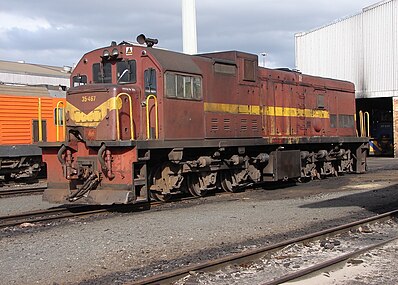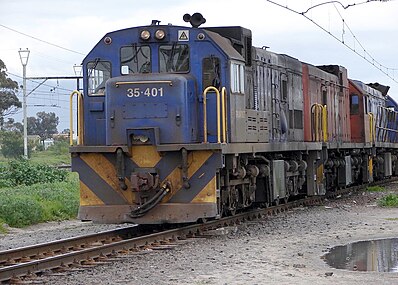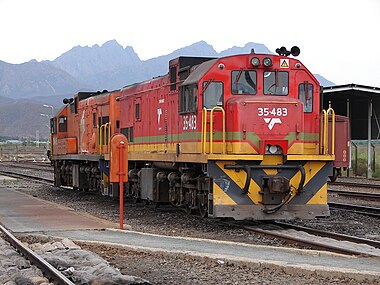South African Class 35-400
| South African Class 35-400 | |||||||||||||||||||||||||||||||||||||||||||||||||||||||||||||||||||||||||||||||
|---|---|---|---|---|---|---|---|---|---|---|---|---|---|---|---|---|---|---|---|---|---|---|---|---|---|---|---|---|---|---|---|---|---|---|---|---|---|---|---|---|---|---|---|---|---|---|---|---|---|---|---|---|---|---|---|---|---|---|---|---|---|---|---|---|---|---|---|---|---|---|---|---|---|---|---|---|---|---|---|
 No. 35-406 at Stikland, Cape Town, 13 March 2007 | |||||||||||||||||||||||||||||||||||||||||||||||||||||||||||||||||||||||||||||||
| |||||||||||||||||||||||||||||||||||||||||||||||||||||||||||||||||||||||||||||||
| |||||||||||||||||||||||||||||||||||||||||||||||||||||||||||||||||||||||||||||||
| |||||||||||||||||||||||||||||||||||||||||||||||||||||||||||||||||||||||||||||||
| |||||||||||||||||||||||||||||||||||||||||||||||||||||||||||||||||||||||||||||||
The South African Railways Class 35-400 of 1976 is a diesel-electric locomotive.
Between March 1976 and May 1980, the South African Railways placed one hundred Class 35-400 General Electric type U15C diesel-electric locomotives in branch line service.[1][2]
Manufacturer
The Class 35-400 type GE U15C diesel-electric locomotive was designed by General Electric (GE) and built for the South African Railways (SAR) by the South African General Electric-Dorman Long Locomotive Group (SA GE-DL, later Dorbyl). The first batch of fifty locomotives was delivered between March and December 1976, numbered in the range from 35–401 to 35-450. These were followed by a second batch of fifty between October 1978 and May 1980, numbered in the range from 35-451 to 35-500.[1][2][3]
Distinguishing features

The locomotive has interlinked bogies, hence the "Co+Co" wheel arrangement classification. The linkage is usually hidden from view by the saddle-shaped fuel tank.
With the two GE U15C Class 35 models, the Class 35-000 can be distinguished from the Class 35-400 by the length of the humps on their long hoods, the Class 35-000 having a hump that is more than twice as long as that of the Class 35-400. An externally visible modification which was done during major overhauls is the addition of a saddle hood astride the long hump of the Class 35-000. By 2013 this modification had been done on a large number of long-humped Class 35-000 units, but no similar modification was done on any short-humped Class 35-400.[4][5]
Service
South African Railways

The Class 35 family is South Africa's standard branch line diesel-electric locomotive. The GE Class 35-400 was designed to operate on light rail and they work on most branch lines in the central, western, southern and southeastern parts of the country.[3]
In the Western Cape, they work out of Bellville Depot in Cape Town on the branch lines to Bitterfontein, Saldanha and Caledon, and out of Worcester to George. Since the Ceres branch was reopened during 2012 in terms of an agreement between the Ceres Rail Company and Transnet, they also work fruit container trains in that line during the fruit season.[6]
NLPI Ltd.
NLPI Limited, abbreviated from New Limpopo Projects Investments, is a Mauritius-registered company which specialises in private sector investments, using the build-operate-transfer (BOT) concept. It had three connected railway operations in Zimbabwe and Zambia that formed a rail link between South Africa and the Democratic Republic of Congo.[1]
- The Beitbridge Bulawayo Railway (BBR) was commissioned on 1 September 1999 and operates the Beit Bridge to Bulawayo line in Zimbabwe.
- Since February 2004 NLPI Logistics (NLL or LOG) has been operating between Bulawayo and Victoria Falls on the Zimbabwe-Zambia border.
- Since February 2003, the Railway Systems of Zambia (RSZ) operated on the former Zambia Railways (ZR) line from Victoria Falls to Sakania in the Congo.
In Zambia, the RSZ locomotive fleet included former Zambia Railways locomotives, but the rest of the locomotive fleet of all three operations consisted of South African GM-EMD Classes 34-200, 34-600 and 34-800 and GE Classes 35-000 and 35-400 locomotives, supplied by Transnet Freight Rail (TFR). These locomotives were sometimes marked as either BBR or LOG or both, but their status, whether leased or loaned, was unclear since they were still on the TFR roster and still often worked in South Africa as well. The locomotives did not appear to be restricted to work in any one of the three operations sections and have been observed being transferred between Zimbabwe and Zambia across the bridge at Victoria Falls as required. Class 35-400 locomotives which serve with NLPI include the locomotives annotated "NLPI" in the "leased or loaned" column in the table.[1][7]
Zambia Railways, the state-owned holding company, resumed control of the Zambian national rail network on 11 September 2012. This followed the Zambian government's decision to revoke the operating concession which had been awarded to RSZ after Finance Minister Alexander Chikwanda claimed that RSZ had "blatantly disregarded the provisions of the agreement" and had been "acting in a manner prejudicial to the interests of Zambians”.[8]
Tanzania Railways
Ten Class 35-400 locomotives were leased to Tanzania Railways, where they were regauged to Metre gauge. Locomotives which served there include the ones annotated "Tanzania" in the "leased or loaned" column in the table.[1]
Zaire
Class 35-400 locomotives were also leased to Société Nationale des Chemins de Fer Zaïrois (SNCZ) in Zaire and were occasionally used by Zambia Railways on their journey north through Zambia. This was done with the agreement of SNCZ, who stipulated that they could only haul transit traffic for Zaire. Class 35-400 locomotives which were noted in such service through Zambia were, amongst others, two unidentified locomotives at Kabwe in August 1981, no. 35–464 at Choma in May 1985, no. 35–451 at Lusaka in February 1986, and another unidentified locomotive at Lusaka in May 1990, all under power on northbound goods.[9]
Works numbers
The Class 35-400 builder's works numbers and known international deployment are listed in the table.[1]
Loco no. | Works no. | Leased or Loaned |
|---|---|---|
| 35-401 | 40520 | NLPI |
| 35-402 | 40521 | NLPI |
| 35-403 | 40522 | |
| 35-404 | 40523 | |
| 35-405 | 40524 | NLPI |
| 35-406 | 40525 | NLPI |
| 35-407 | 40526 | NLPI |
| 35-408 | 40527 | |
| 35-409 | 40528 | |
| 35-410 | 40529 | |
| 35-411 | 40530 | |
| 35-412 | 40531 | |
| 35-413 | 40532 | |
| 35-414 | 40533 | |
| 35-415 | 40534 | |
| 35-416 | 40535 | |
| 35-417 | 40536 | |
| 35-418 | 40537 | |
| 35-419 | 40538 | |
| 35-420 | 40539 | |
| 35-421 | 40540 | |
| 35-422 | 40541 | |
| 35-423 | 40542 | |
| 35-424 | 40543 | |
| 35-425 | 40544 | |
| 35-426 | 40545 | |
| 35-427 | 40546 | |
| 35-428 | 40547 | |
| 35-429 | 40548 | NLPI |
| 35-430 | 40549 | |
| 35-431 | 40550 | NLPI |
| 35-432 | 40551 | NLPI |
| 35-433 | 40552 | |
| 35-434 | 40553 | NLPI |
| 35-435 | 40554 | |
| 35-436 | 40555 | NLPI |
| 35-437 | 40556 | |
| 35-438 | 40557 | |
| 35-439 | 40558 | |
| 35-440 | 40559 | |
| 35-441 | 40560 | |
| 35-442 | 40561 | |
| 35-443 | 40562 | |
| 35-444 | 40563 | |
| 35-445 | 40564 | |
| 35-446 | 40565 | |
| 35-447 | 40566 | |
| 35-448 | 40567 | |
| 35-449 | 40568 | |
| 35-450 | 40569 | |
| 35-451 | 41300 | SNCZ |
| 35-452 | 41301 | |
| 35-453 | 41302 | |
| 35-454 | 41303 | Tanzania |
| 35-455 | 41304 | Tanzania |
| 35-456 | 41305 | Tanzania |
| 35-457 | 41306 | Tanzania |
| 35-458 | 41307 | |
| 35-459 | 41308 | |
| 35-460 | 41309 | |
| 35-461 | 41310 | NLPI |
| 35-462 | 41311 | |
| 35-463 | 41312 | NLPI |
| 35-464 | 41313 | SNCZ |
| 35-465 | 41314 | |
| 35-466 | 41315 | |
| 35-467 | 41316 | |
| 35-468 | 41317 | |
| 35-469 | 41318 | |
| 35-470 | 41319 | |
| 35-471 | 41320 | |
| 35-472 | 41321 | |
| 35-473 | 41322 | |
| 35-474 | 41323 | |
| 35-475 | 41324 | |
| 35-476 | 41325 | |
| 35-477 | 41326 | Tanzania |
| 35-478 | 41327 | |
| 35-479 | 41328 | |
| 35-480 | 41329 | |
| 35-481 | 41330 | Tanzania |
| 35-482 | 41331 | |
| 35-483 | 41332 | Tanzania |
| 35-484 | 41333 | |
| 35-485 | 41334 | Tanzania |
| 35-486 | 41335 | Tanzania |
| 35-487 | 41336 | |
| 35-488 | 41337 | Tanzania |
| 35-489 | 41338 | |
| 35-490 | 41339 | |
| 35-491 | 41340 | |
| 35-492 | 41341 | |
| 35-493 | 41342 | |
| 35-494 | 41343 | |
| 35-495 | 41344 | |
| 35-496 | 41345 | |
| 35-497 | 41346 | |
| 35-498 | 41347 | |
| 35-499 | 41348 | |
| 35-500 | 41349 |
Liveries
The Class 35-000 were all delivered in the SAR Gulf Red livery with signal red buffer beams, yellow side stripes on the long hood sides and a yellow V on each end. In the 1990s many of the Class 35-400 units began to be repainted in the Spoornet orange livery with a yellow and blue chevron pattern on the buffer beams. In the late 1990s many were repainted once again, this time in the Spoornet blue livery with outline numbers on the long hood sides. After 2008 in the Transnet Freight Rail (TFR) era many were repainted in the TFR red, green and yellow livery.[1][10]
Illustration
The last picture below shows the roof of a Class 35-400 U15C locomotive. It was involved in a major derailment near Moorreesburg on 7 June 2007 after the track roadbed was washed away during heavy rain and flooding.[11]
- No. 35–467 in SAR Gulf Red and yellow whiskers livery, Bellville loco depot, Cape Town, 24 May 2009
- No. 35–403 in an early version of Spoornet's orange with a wide gray top edge, Stikland, 19 October 2006
- No. 35–401 in Spoornet blue livery with outline numbers, Stikland, Cape Town, 16 August 2006
- No. 35–483 in Transnet Freight Rail livery, Worcester Depot, Western Cape, 26 March 2013
- No. 35–403 in Spoornet orange livery at Biesiesfontein Farm outside Moorreesburg, 9 June 2007
References
- ^ a b c d e f g Middleton, John N. (2002). Railways of Southern Africa Locomotive Guide - 2002 (as amended by Combined Amendment List 4, January 2009) (2nd, Dec 2002 ed.). Herts, England: Beyer-Garratt Publications. pp. 38, 42.
- ^ a b South African Railways Index and Diagrams Electric and Diesel Locomotives, 610mm and 1065mm Gauges, Ref LXD 14/1/100/20, 28 January 1975, as amended
- ^ a b Paxton, Leith; Bourne, David (1985). Locomotives of the South African Railways (1st ed.). Cape Town: Struik. pp. 141–142. ISBN 0869772112.
- ^ "35-003 without saddle filter".
- ^ "35-001 with saddle filter".
- ^ Ceres Rail Company: The Story So Far (Accessed on 16 June 2017)
- ^ Railways Africa, 7 Dec 2006: 35 Class Diesels
- ^ ZRL in charge as RSZ concession revoked. Railway Gazette International, 13 September 2012
- ^ Spoornet Diesels Leased to ZR 1978-1993. P.F. Bagshawe.
- ^ Soul of A Railway, System 7, Western Transvaal, based in Johannesburg, Part 9. South-Eastwards as far as Volksrust (2nd part) by Les Pivnic. Caption 4. Archived 24 July 2021 at the Wayback Machine (Accessed on 11 April 2017)
- ^ Derailment at Moorreesburg on 7 June 2007
External video link
| External videos | |
|---|---|
 In March 2017, we follow a quartet of vintage 35 Class diesels going about their daily work on the spectacular Cape Town to Caledon and Klipdale railway. The 35s pick up a load from Klipdale and work their way back towards Cape Town. After dropping wagons at Caledon, the 35s make their way through the tight curves and grades, with final shots watching the train ascend the tortuous curves of Houwhoek Pass. Numbers 35-467, 35-034, 35-483 & 35-043, Trevor Staats, March 2017 (5m 28s) In March 2017, we follow a quartet of vintage 35 Class diesels going about their daily work on the spectacular Cape Town to Caledon and Klipdale railway. The 35s pick up a load from Klipdale and work their way back towards Cape Town. After dropping wagons at Caledon, the 35s make their way through the tight curves and grades, with final shots watching the train ascend the tortuous curves of Houwhoek Pass. Numbers 35-467, 35-034, 35-483 & 35-043, Trevor Staats, March 2017 (5m 28s) |

- v
- t
- e
- SAR Class ES
- SAR Class ES1
- SAR Class Exp-AC
- SAR Class 1E
- SAR Class 2E
- SAR Class 3E
- SAR Class 4E
- SAR Class 5E s1
- SAR Class 5E s2
- SAR Class 5E s3
- SAR Class 5E1 s1
- SAR Class 5E1 s2
- SAR Class 5E1 s3
- SAR Class 5E1 s4
- SAR Class 5E1 s5
- SAR Class 6E
- SAR Class 6E1 s1
- SAR Class 6E1 s2
- SAR Class 6E1 s3
- SAR Class 6E1 s4
- SAR Class 6E1 s5
- SAR Class 6E1 s6
- SAR Class 6E1 s7
- SAR Class 6E1 s8
- SAR Class 6E1 s9
- SAR Class 6E1 s10
- SAR Class 6E1 s11
- SAR Class 7E
- SAR Class 7E1
- SAR Class 7E2 s1
- SAR Class 7E2 s2
- SAR Class 7E3 s1
- SAR Class 7E3 s2
- Spoornet Class 7E4
- SAR Class 8E
- SAR Class 9E s1
- SAR Class 9E s2
- SAR Class 10E
- SAR Class 10E1 s1
- Spoornet Class 10E1 s2
- SAR Class 10E2
- SAR Class 11E
- SAR Class 12E
- Spoornet Class 14E
- Spoornet Class 14E1
- TFR Class 15E
- Spoornet Class 16E
- Spoornet Class 17E
- Spoornet Class 18E s1
- TFR Class 18E s2
- TFR Class 19E
- TFR Class 20E
- TFR Class 21E
- TFR Class 22E
- TFR Class 23E















